Building your own backyard pickleball court: a comprehensive guide
Transforming your backyard into a pickleball court can be a rewarding project that adds value, fun, and fitness to your daily life. Whether you’re a seasoned player or a newcomer to the game, building a DIY backyard pickleball court can provide endless hours of enjoyment for you and your family. Here’s a comprehensive guide to help you navigate through the process, ensuring that every detail is well-planned and executed to perfection.

Planning and Preparation
Before diving into construction, thorough planning and preparation are vital. This stage involves determining your available space and budget, assessing your existing surface, and researching local regulations.
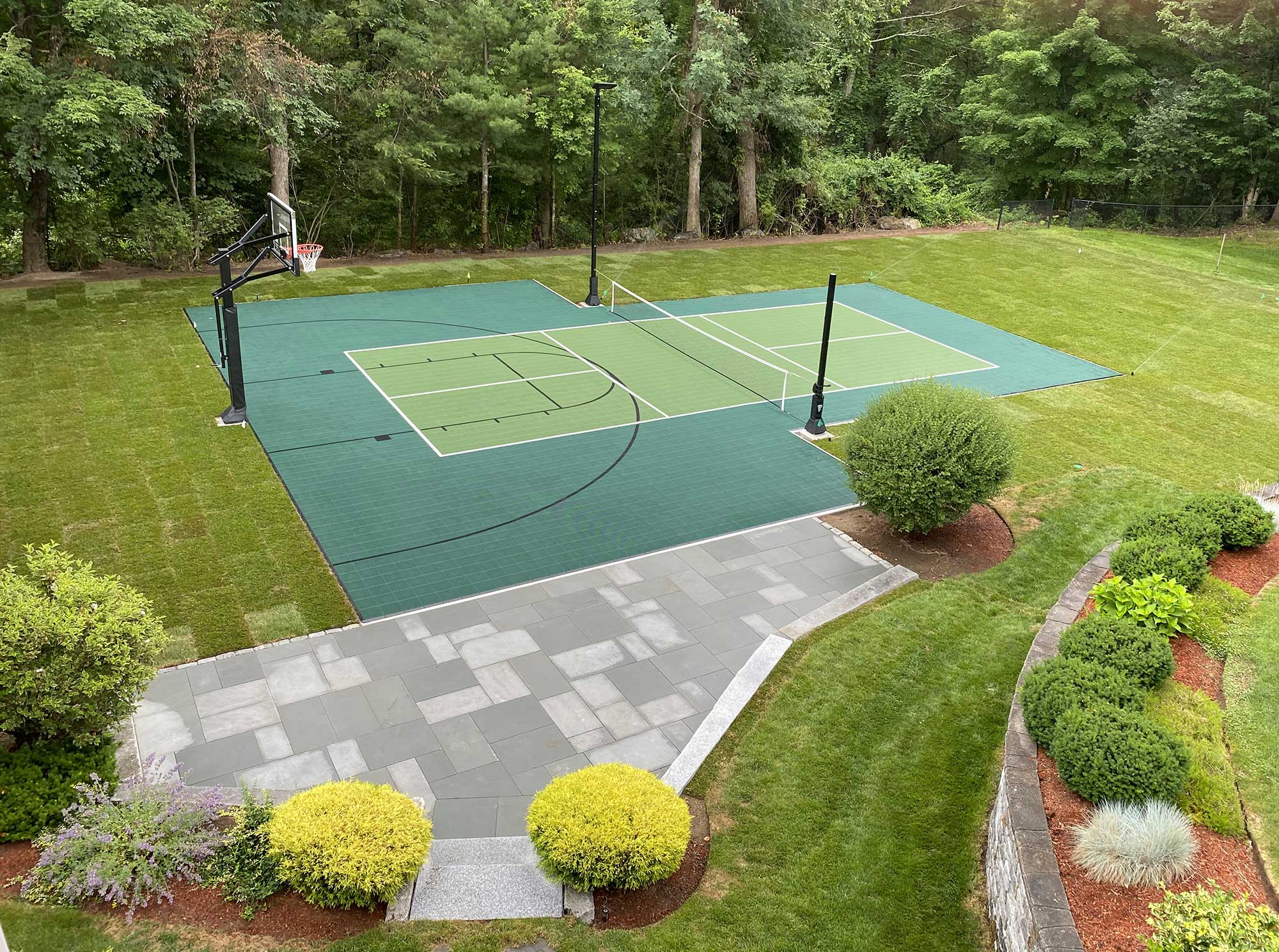
1. Determine your space and budget
When planning to build a backyard pickleball court, the first step is to assess the available space in your backyard. A standard pickleball court size is 20 feet wide and 44 feet long, including the non-volley zones or “kitchen” areas. Ensure that the area you select for your backyard pickleball court meets these dimensions and has a flat, smooth surface.
Next, you’ll need to consider your budget. Building a budget-friendly pickleball court costs around $5,000-$10,000. This includes expenses for materials such as the court surface, paint for the lines, net system, and any additional features like fencing or lighting.
To save on costs, you can opt for cost-effective surface options like asphalt or concrete and use anti-slip paint to create a durable and slip-resistant playing surface. Additionally, you can explore DIY methods for marking the court lines to further reduce expenses.
Before finalizing your plans, be sure to check with your local authorities regarding any necessary permits or homeowner association rules that may apply to your backyard pickleball court project. This will help ensure that your construction plans are in compliance with local regulations.
2. Assess your existing surface
The second step in building a backyard pickleball court is to assess the existing surface and prepare the area. This is crucial for ensuring a stable and level playing surface.
First, you need to clear the area of any debris, rocks, or grass using a shovel or rake. It is essential to have a clean and level playing area. Take the time to remove any obstacles that may hinder the smoothness of the playing surface.
Next, you will need to excavate the area within the court boundaries to a depth of approximately 4-6 inches. This will allow for proper drainage and ensure a stable court. Use a shovel or a small excavator for this task, taking care to maintain the leveling and evenness of the surface throughout the excavation process.
After excavating, you will need to install a base material, such as crushed stone or gravel. Spread and compact the base material evenly within the excavated area, ensuring a depth of around 2-3 inches. Use a plate compactor to achieve a solid and stable surface. This base material will provide a sturdy foundation for the court.
Selecting a flat and smooth surface is essential for your backyard pickleball court. Ensure that there are no obstacles like trees or big rocks in the way, as they can interfere with the playing area.
By carefully assessing the existing surface and preparing the area, you can create a stable and level foundation for your backyard pickleball court, ensuring a safe and enjoyable playing experience.
3. Research local regulations and permits
Before building a backyard pickleball court, it is crucial to thoroughly research and understand the local regulations and permit requirements in your area. This planning and preparation step is essential to ensure your project complies with all applicable laws and avoids any potential issues down the line.
Firstly, you should check with your local government or homeowner’s association to determine if any permits are required to construct a pickleball court in your backyard. Many municipalities have specific guidelines and ordinances regarding the construction of outdoor recreational facilities.
Obtaining the necessary permits is important, as failure to do so could result in fines or even legal action. The permit process may involve submitting plans for your court, providing details on the location within your property, and potentially addressing any environmental impact.
Additionally, you should review your local zoning laws to ensure the placement of your pickleball court aligns with any regulations regarding setbacks from property lines, proximity to neighboring structures, or restrictions on the type of recreational amenities allowed in your area.
Some homeowner’s associations may also have specific rules or guidelines regarding the size, appearance, and location of backyard pickleball courts. It is crucial to understand and comply with these requirements to avoid any issues with your neighbors or the association.
By thoroughly researching the local regulations and obtaining the necessary permits, you can ensure your backyard pickleball court project is completed in a compliant and hassle-free manner. This planning and preparation step will help you avoid any unexpected challenges or delays down the line.
Court Design and Layout
Creating an effective design and layout is a critical step in ensuring that your backyard pickleball court meets all necessary standards for a satisfying gameplay experience.
4. Choose the right court size
The standard dimensions for a pickleball court are 20 feet wide by 44 feet long. This makes the court slightly smaller than a standard doubles tennis court. The court is divided into two equal halves by a net that is 36 inches high at the sidelines and 34 inches high at the center.
When designing a backyard pickleball court, it’s important to ensure you have enough available space to accommodate these dimensions. The court should have a minimum of 2-4 feet of clearance on all sides to allow players to move freely without risk of colliding with surrounding structures or objects.
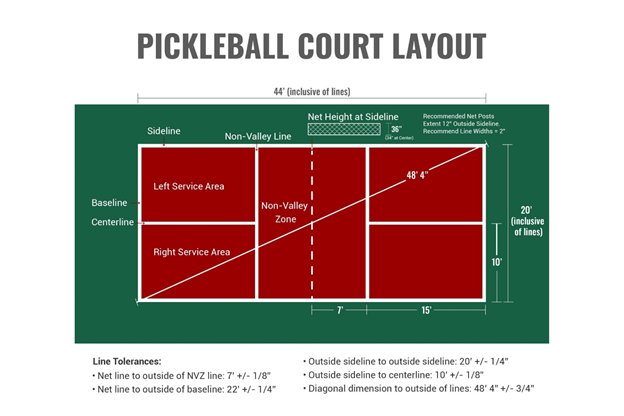
In addition to the overall court dimensions, there are several key zones and markings that need to be included:
- The non-volley zone (also called the “kitchen”) extends 7 feet from the net on each side. Players are not allowed to volley the ball while standing in this area.
- The service area is located behind the baseline, with separate left and right service courts.
- The centerline divides the court in half and extends from the non-volley zone to the baseline.
When constructing the backyard court, you can use materials like concrete, asphalt, or specialized sport court surfaces. Proper drainage is also important to prevent water buildup on the playing surface.
By following these guidelines for court dimensions, layout, and construction, you can create a regulation-sized backyard pickleball court that provides an optimal playing experience.
5. Mark the court lines and dimensions
To mark the court lines and dimensions on your backyard pickleball court, follow these steps:
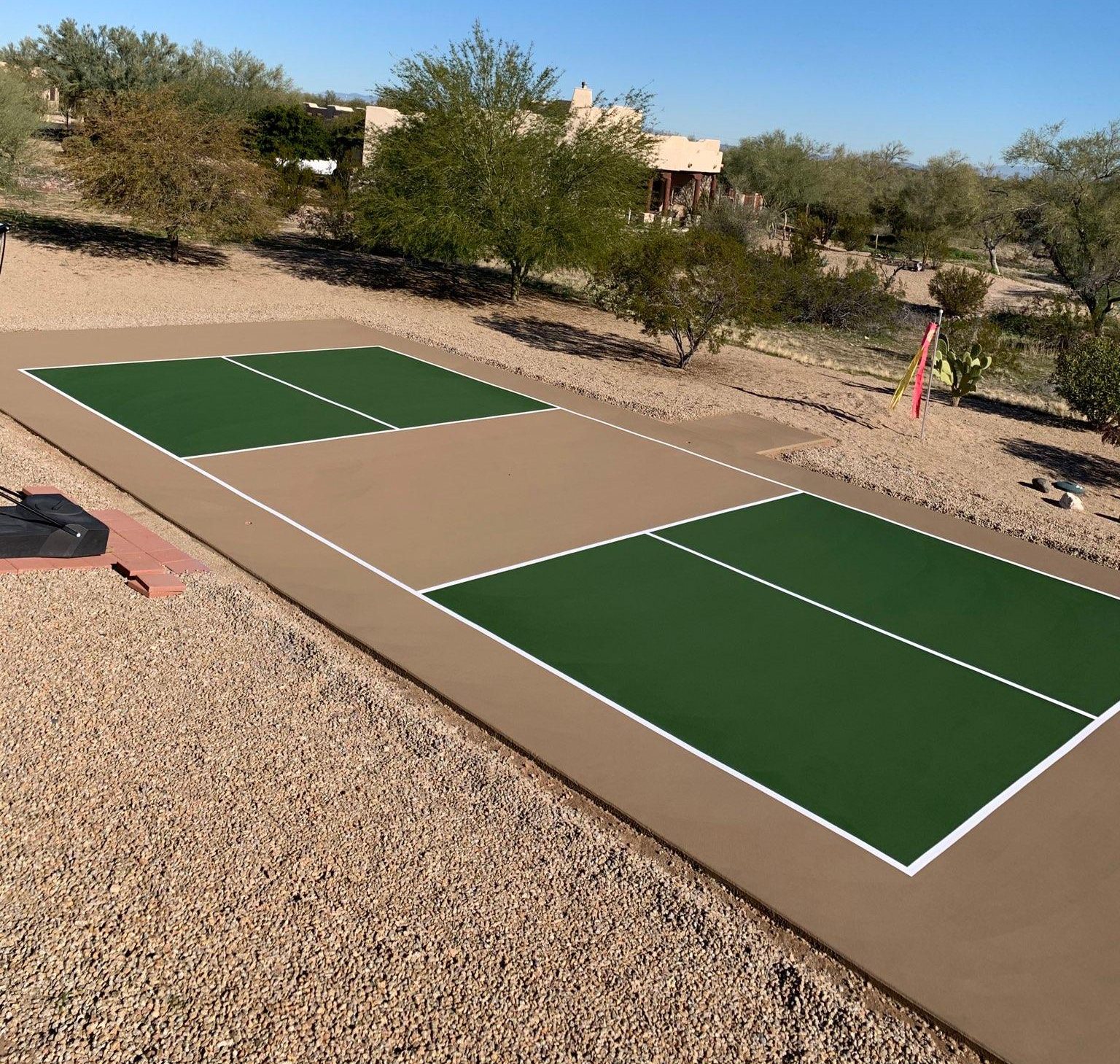
- Baselines and sideline measurement:
- Use a tape measure or string line to accurately mark out the 20′ x 44′ court dimensions.
- Paint the lines:
- Paint the following lines on the court surface:
- Baselines (2)
- Service lines (2)
- Centerline (1)
- Non-volley zone lines (2), extending 7 feet from the net
- Sidelines (2)
- Paint the following lines on the court surface:
- Contrasting color for non-volley zone:
- Use a contrasting color of paint for the non-volley zone lines to make them clearly visible.
- Line width and spacing consistency:
- Ensure all lines are painted with consistent width and spacing. Consider using stencils for best results.
- Allow paint to dry fully:
- Allow the paint to fully dry before using the court.
Following these guidelines will ensure your backyard pickleball court has the proper dimensions and markings for regulation play.
6. Consider fencing and net installation
Installing a fence or enclosure is a crucial step towards creating a pickleball court in your backyard. Choose a suitable fencing material, measure, and mark the area for the fence, install fence posts and secure them in the ground, attach the fencing material to the posts, and ensure the fence is secure and provides a boundary for the court.
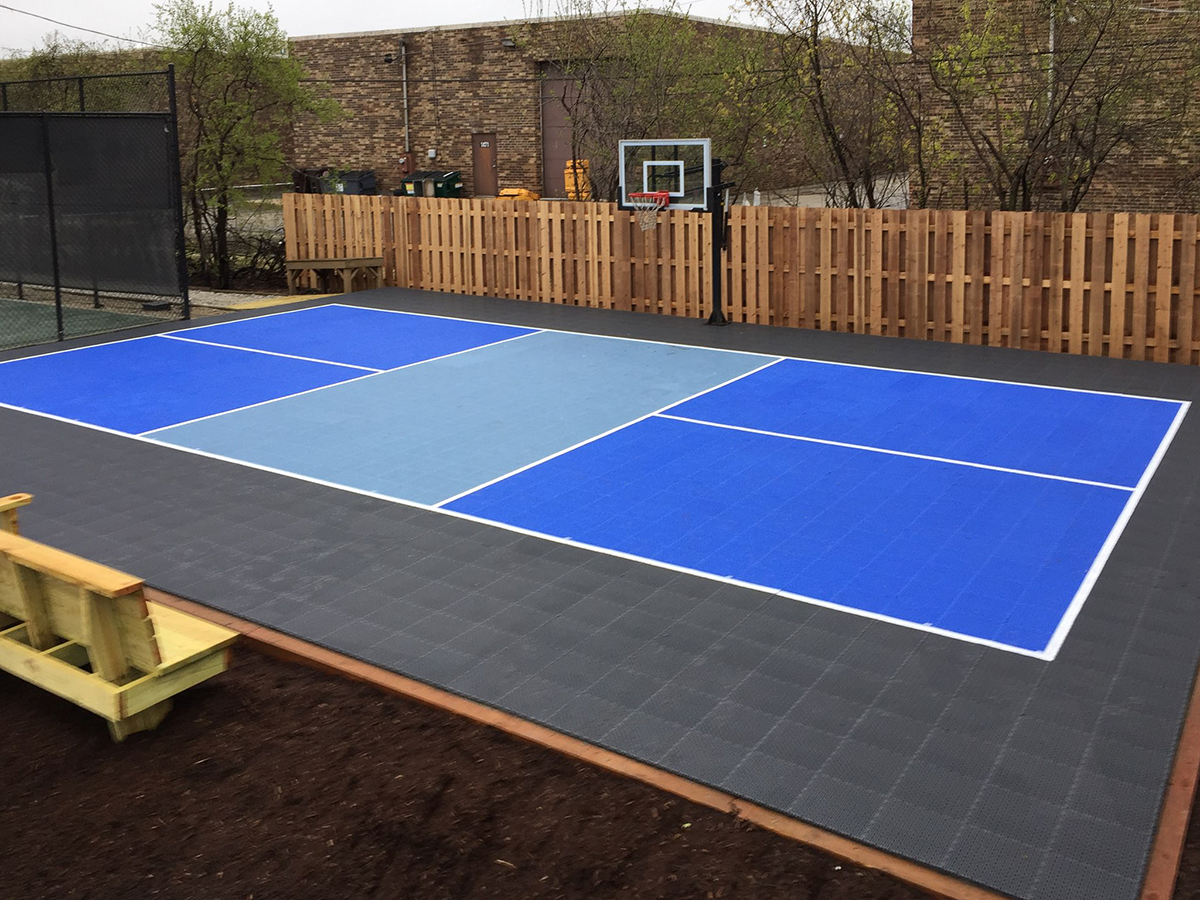
Here’s a checklist for fencing and net installation:
Fencing Material Selection Tables comparing fencing types could be effective:
| Fencing Material | Pros | Cons |
|---|---|---|
| Chain-link | Durable, weather-resistant | Less aesthetically pleasing |
| Wooden panels | Visually appealing, natural look | Requires more maintenance |
| Mesh | Cost-effective, flexible | May be less durable than others |
Net Specifications The pickleball net is another essential component of the court. According to USA Pickleball, the net should be 36 inches high at the edges of the court and 34 inches in the center. When you set up your net, it should stick out on the sides of the court by about a foot.
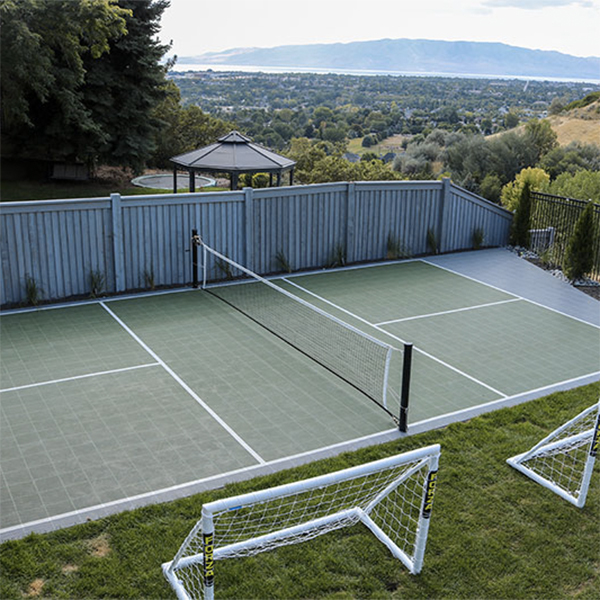
By considering the appropriate fencing and net installation requirements, you can avoid potential issues and ensure a smooth build process for your backyard pickleball court.
Surface Construction
Creating a high-quality playing surface is crucial for the performance and longevity of your pickleball court. From surface preparation to applying a durable coating, each step requires attention to detail and suitable materials.
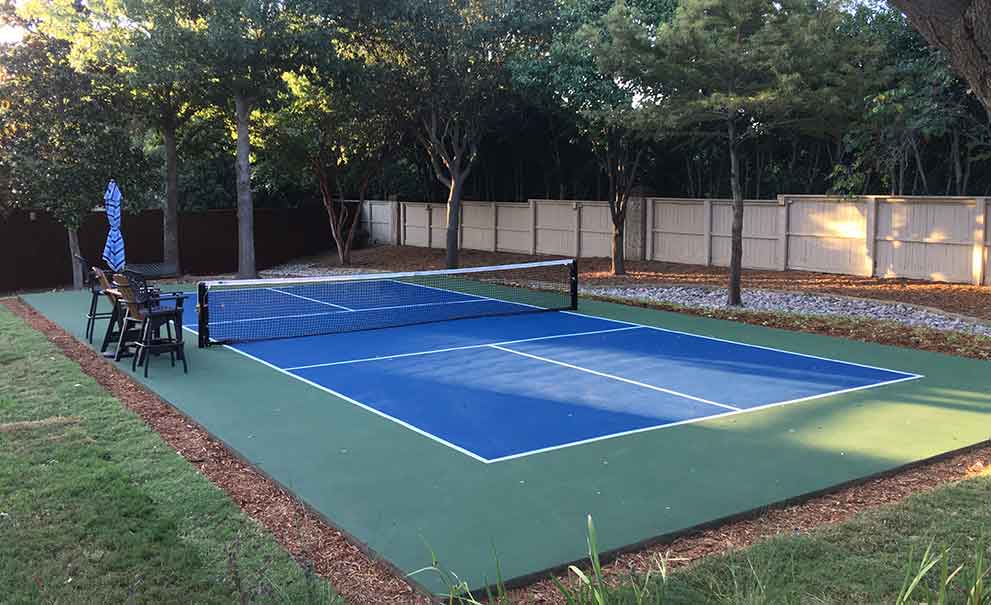
7. Prepare the existing surface
The process of preparing the existing surface is a crucial step in constructing a backyard pickleball court. According to the sources, this involves several key steps:
- Space assessment:
- The first step for building a backyard pickleball court is to assess the available space. Selecting a flat and smooth surface is essential. This means clearing the area of any debris, rocks, or grass using a shovel or rake.
- Excavation:
- Once the space has been identified, the area within the boundaries needs to be excavated to a depth of approximately 4-6 inches. This allows for proper drainage and ensures a stable court base.
- Base material installation:
- After excavation, a base material such as crushed stone or gravel is installed and compacted evenly within the excavated area, typically to a depth of 2-3 inches. This provides a solid and stable foundation for the court.
- Surface coating:
- For the playing surface, a popular choice is an acrylic paint coating. This provides a smooth and durable finish. The acrylic paint is applied evenly across the compacted base using a paint roller or sprayer.
By carefully preparing the existing surface through excavation, installing a proper base material, and applying the final playing surface, a sturdy and level backyard pickleball court can be constructed. This meticulous attention to surface preparation is crucial for ensuring a high-quality, safe, and enjoyable playing experience.
8. Install a stable base material
The base layer provides stability and support for your pickleball court’s surface material. The choice of base material depends on your selected playing surface.
| Base Material | Depth | Use |
|---|---|---|
| Gravel | 2-3 inches | For maintaining drainage |
| Crushed stone | 2-3 inches | Elevated stability and support |
| Compacted soil | 1-2 inches | Temporary, less recommended |
By installing a stable base material, you create a solid foundation that will support the playing surface and contribute to the longevity and performance of the backyard pickleball court.
9. Apply a durable surface coating
The recommended surface coating for a backyard pickleball court is a 100% acrylic coating. These acrylic coatings are breathable and allow for some vapor transmission, which is important for outdoor courts. The PickleMaster coating, which is the official court surface of USA Pickleball, is a 100% acrylic coating that is factory-mixed with a specialized blend of aggregate to create an ideal surface texture for non-slip footing and true pickleball bounce.
Acrylic coatings can also be applied over cushioned layers to provide additional shock absorption and comfort for players. This cushioned surface helps reduce stress on the feet, joints, and body.
For maintenance, the acrylic court surfaces require regular cleaning by sweeping to remove debris, dust, and leaves. Deeper cleaning can be done using gentle cleaners and water, avoiding harsh chemicals that can damage the coating. The courts may only need cleaning when visibly dirty, as outdoor courts often get cleaned naturally by wind and rain.
Overall, 100% acrylic coatings like PickleMaster provide a durable, slip-resistant, and cushioned surface that is well-suited for backyard pickleball courts in the United States.
Finishing Touches
Adding the final touches to your pickleball court is about ensuring functionality, safety, and aesthetics. This stage covers painting lines, installing nets, adding lighting, and incorporating amenities.
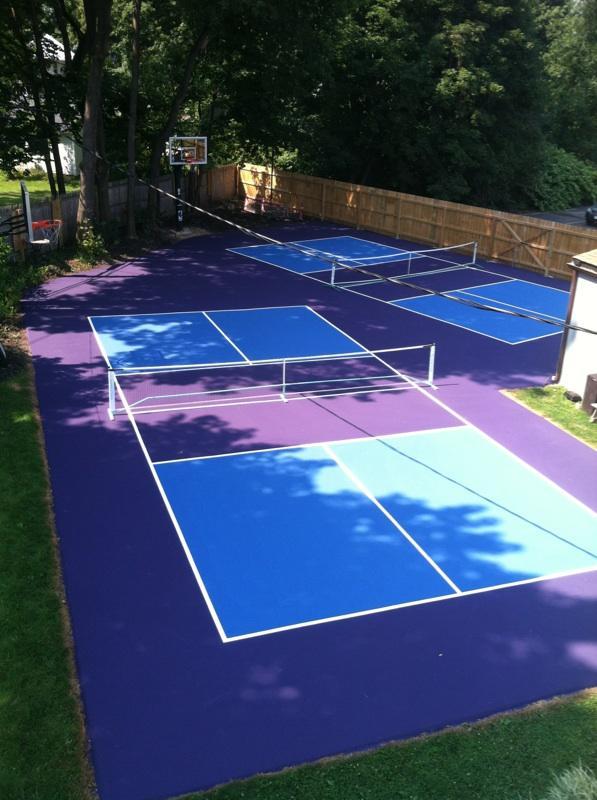
10. Paint the court lines and boundaries
To paint the court lines and boundaries, start by using masking tape and a steel tape measure to get the lines nice and straight.
- Marking baselines and sidelines:
- Set up two 44 ft. lines across from each other, then create a parallel line 2 inches in from the first one to get the baselines. Extend these to 20 ft. to create the sidelines.
- Non-volley zone line:
- Measure 15 ft. from the baseline and mark the non-volley line, creating a parallel line 2 inches in from that as well. This outlines the non-volley zone or “kitchen”.
- Centerline marking:
- Measure 10 ft. from the sidelines and draw a centerline down the middle of the court.
- Optional play area lining:
- Line the 30 ft. x 60 ft. play area by measuring 5 ft. out from the sidelines and 13 ft. out from the baselines, and lay down tape there.
Once the lines are marked, use a foam roller to paint between the masking tape, applying at least two coats for a vibrant, durable finish. Be sure to remove the tape carefully at an angle to get clean, crisp lines.
This process of precisely measuring, taping, and painting the court lines and boundaries is essential for creating a professional-looking backyard pickleball court.
11. Install the net system
The final step in building a backyard pickleball court is to install the net system. According to the information provided, there are two main options for the net system – a portable net system or a permanent net system.

- Portable net system:
- The net can be easily moved around and set up when needed. This is good for flexibility and socializing; however, the net has to be put up and taken down each time.
- Permanent net system:
- The net posts are installed permanently in the ground. This gives the court a more professional look, and the net can stay up all the time without needing to be set up each use. However, the permanent system requires more installation work.
Regardless of which net system you choose, the key specifications are:
- The net should be at least 20 feet wide, extending from one sideline to the other.
- The net height must be 36 inches at the sidelines and 34 inches at the center. This 2-inch difference makes it easier to hit the ball over the middle of the net.
- The net system should include the net, ratchet, two poles, and sleeves to secure the poles.
When installing the net, make sure to properly tension it and adjust the height to the correct 36/34 inch specification. This will ensure the net meets regulation standards and provides the optimal playing experience.
Overall, choosing the right net system and installing it properly are the final important steps to complete your backyard pickleball court.
12. Add lighting for evening play
When adding lighting to a backyard pickleball court for evening play, there are several key factors to consider to ensure optimal visibility and performance:
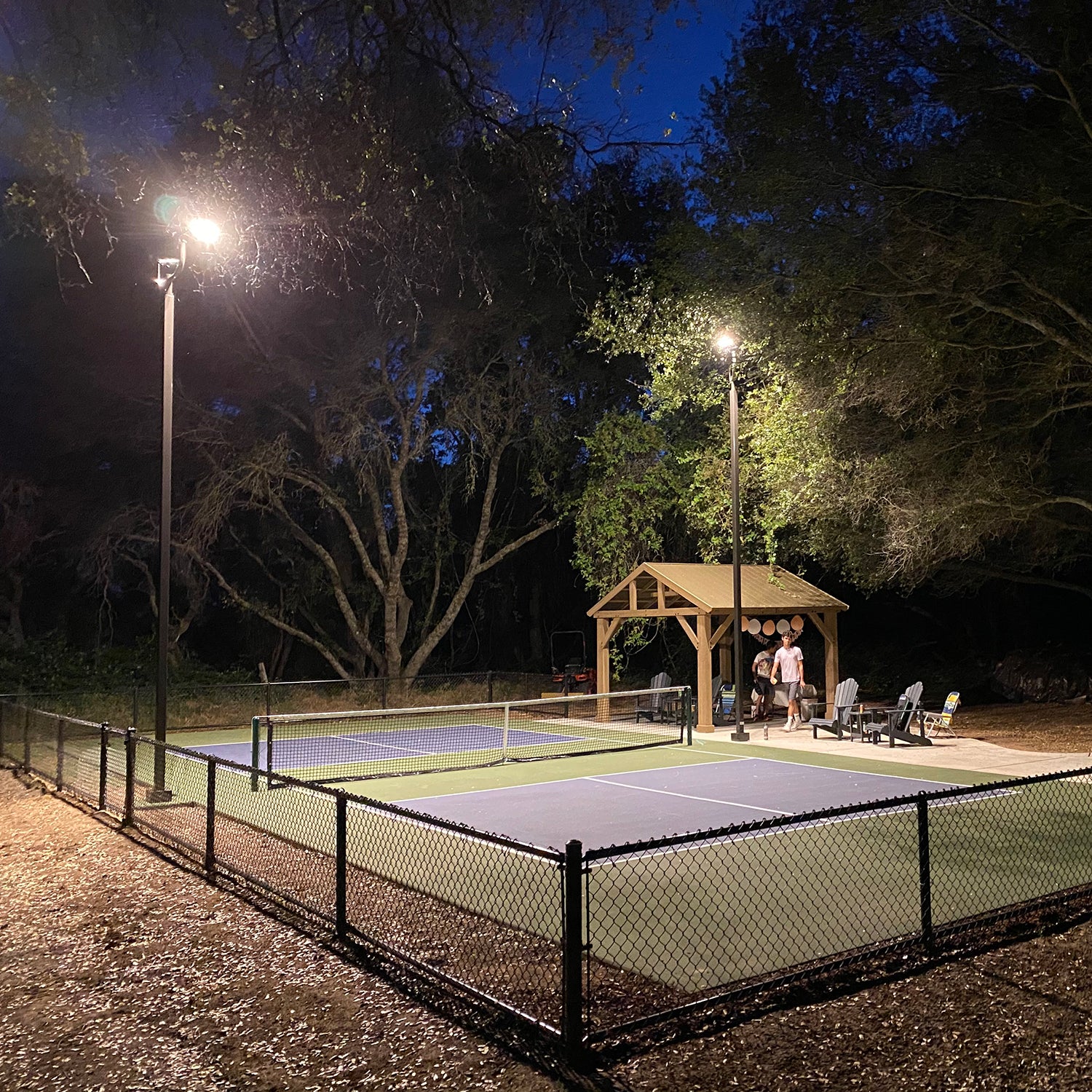
Lighting Level Requirements: The recommended lighting level for pickleball courts is a minimum of 30-foot candles (fc) for recreational play and 50 fc for competitive play. This level of illumination ensures players can clearly see the ball, court lines, and other players.
Lighting Fixture Placement: The lighting fixtures should be strategically positioned to provide uniform illumination across the entire court, including the non-volley zones. Typically, spotlights mounted on 20-foot high poles are used to achieve the recommended lighting levels.
Lighting Fixture Type: LED lighting fixtures are the preferred choice for backyard pickleball courts due to their energy efficiency, long lifespan, and ability to produce bright, uniform illumination. LED lights also offer instant-on capabilities and can be dimmed or adjusted as needed.
Lighting Controls and Automation: Consider incorporating lighting controls and automation features to enhance convenience and energy savings. This can include remote control capabilities, motion sensors, and scheduling functions to turn the lights on and off automatically based on usage.
Maintenance and Durability: Ensure the lighting fixtures are designed to withstand the outdoor conditions of a backyard setting, including impacts, water, sunlight, and extreme temperatures. Regular maintenance and inspection of the lighting system are also important.
By following these guidelines and considerations, you can create a well-lit backyard pickleball court that allows for safe and enjoyable evening play.
13. Incorporate amenities and seating
When building a backyard pickleball court, adding amenities and seating can enhance the overall experience and make it more enjoyable for players.
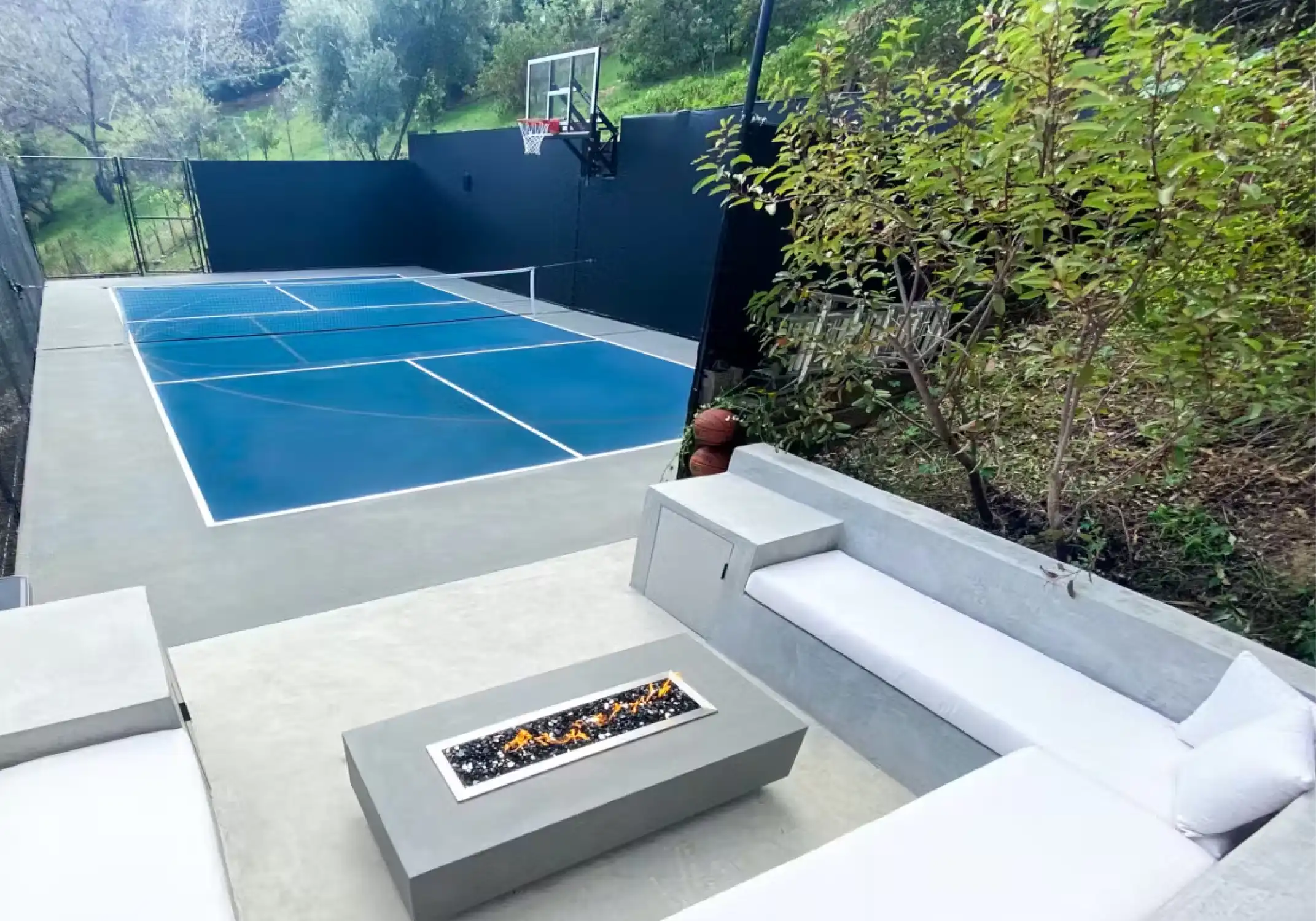
Seating:
- Adding benches or chairs around the court provides a comfortable place for players to rest between games or for spectators to watch. These can be simple wooden or metal benches or more elaborate seating areas with shade structures.
Shade Structures:
- To protect players from the sun, consider installing a shade structure such as an awning or pergola. This can make the court more comfortable to use, especially during hot summer days.
Ball Holders:
- Installing ball holders or ball caddies near the court makes it easy to keep extra balls organized and within reach during play.
Fencing:
- Surrounding the court with fencing helps contain stray balls and provides a defined playing area. Fencing can be 4-6 feet high and made of materials like chain-link or mesh.
Lighting:
- For evening play, installing lighting around the court ensures visibility and allows for extended playing hours. Pole-mounted spotlights or string lights can be effective options.
Storage:
- Incorporating storage space, such as a small shed or cabinet, allows you to keep equipment like paddles, balls, and net components organized and protected.
Landscaping:
- Adding landscaping elements like plants, flowers, or decorative rocks can enhance the aesthetic appeal of the court and create a more inviting atmosphere.
By incorporating these types of amenities and finishing touches, you can transform your backyard pickleball court into a comfortable, functional, and visually appealing recreational space for you and your family to enjoy.
Maintenance and Safety
Ensuring the long-term care and safety of your pickleball court is crucial. Regular maintenance and adherence to safety precautions will enhance the durability and usability of your court.
14. Develop a regular maintenance schedule
Regular maintenance is crucial for ensuring the longevity, safety, and optimal performance of a backyard pickleball court. To develop a comprehensive maintenance schedule, consider the following steps:
- Create a maintenance schedule with daily, weekly, and seasonal tasks: This should include regular cleaning, inspections, and addressing any issues that arise.
- Daily maintenance: Focus on sweeping the court surface to remove debris and dirt. This helps maintain traction and prevent potential tripping hazards.
- Weekly tasks: Include a more thorough inspection of the court surface, looking for cracks, uneven areas, or signs of wear. Address any issues promptly to prevent further deterioration.
- Seasonal maintenance: This isespecially crucial in areas with harsh weather conditions. In the fall, clear the court of leaves, twigs, and other organic matter to prevent staining and damage during the off-season. In the spring, inspect the court for any winter-related damage and make necessary repairs. Ensure proper drainage to prevent water accumulation, which can lead to surface damage and safety hazards. Conduct regular inspections of all court elements, such as the net, posts, and fencing, to ensure everything is in proper working order.
- Regularly check the net and posts for stability, proper tension, and any signs of wear. Adjust the net height as needed to maintain the regulation 34-inch center and 36-inch edge heights.
- Consider reapplying court coatings or sealants periodically to maintain the surface’s texture and grip. Follow the manufacturer’s recommendations for the appropriate frequency.
- Ensure proper drainage to prevent water accumulation, which can lead to surface damage and safety hazards. Regularly check for and address any drainage issues. Keeping the court free from standing water ensures safety and durability.
- Prioritize safety by promptly addressing any cracks, uneven areas, or other hazards that could pose a risk to players. The longevity of the court is not just about aesthetic upkeep but also ensuring that all potential injuries are mitigated through proactive maintenance.
- Maintain records of all maintenance activities, repairs, and any professional services rendered. This documentation can help track expenses and ensure timely upkeep. Keeping detailed records helps you identify patterns and plan for future repairs or upgrades.
- Consult with professionals, such as court construction specialists, for guidance on maintenance best practices tailored to your specific court type and local climate conditions. Expert advice can make a significant difference in both the short-term and long-term quality of your court.
By following this comprehensive maintenance schedule, you can ensure your backyard pickleball court remains in top condition, providing a safe and enjoyable playing experience for years to come.
15. Implement safety precautions
To implement safety precautions for a backyard pickleball court, it is important to focus on both maintenance and safety considerations.
Maintenance Safety:
- Regularly inspect the court surface for any cracks, holes, or uneven areas that could pose tripping hazards. Address these issues promptly by filling cracks or leveling the surface.
- Keep the court clean by sweeping or blowing away debris, dirt, and organic material on a regular basis. This prevents slippery conditions that could cause falls and injuries.
- Maintain the net and posts, checking for any wear, damage, or loose hardware that could compromise safety. Tighten or replace components as needed.
- Ensure proper drainage to avoid standing water, which can make the surface slippery. Address any areas with poor drainage by adjusting grading or drainage systems.
- Regularly trim surrounding vegetation to prevent encroachment onto the court and eliminate potential tripping hazards. This also helps keep the playing area looking neat and attractive.
Safety Precautions for Players:
- Mark the court boundaries and playing lines clearly using contrasting colors to help players stay oriented. This is crucial for maintaining focus and reducing the risk of accidental collisions or trips.
- Provide adequate lighting for the court, especially for evening or night play, to ensure players can see the ball and court features. Proper lighting is fundamental in preventing accidents during low-light conditions.
- Install windbreaks or barriers around the court to minimize disruptions from wind during gameplay. This not only makes playing conditions better but also ensures balls do not stray far, leading to potential hazards.
- Encourage players to wear appropriate non-marking court shoes with good traction to prevent slips and falls. Proper footwear is one of the simplest yet most effective ways to prevent injuries.
- Educate players on court safety rules and etiquette to promote a safe playing environment. This includes understanding and following the “kitchen” rules and ensuring that everyone is aware of their surroundings.
- Keep the court free of any obstacles or equipment when not in use to eliminate tripping hazards. Items like paddles, balls, and personal belongings should be stored in a designated area.
- Consider adding safety netting or fencing around the court perimeter to prevent errant balls from leaving the playing area. This helps protect surrounding property and ensures that balls are easily retrieved.
By implementing these maintenance and safety precautions, you can ensure your backyard pickleball court remains a safe and enjoyable space for players of all skill levels. This holistic approach to safety encompasses both the physical upkeep of the court and the education of its users, ensuring a comprehensive strategy for injury prevention and long-term durability.
Conclusion
Building your own backyard pickleball court is a multi-faceted project that requires careful planning, thoughtful design, strategic construction, and diligent maintenance. By thoroughly considering your available space and budget, preparing the existing surface, adhering to local regulations, and focusing on both the construction and aesthetic aspects of the court, you can create a high-quality playing area that offers endless enjoyment.
Taking the time to invest in maintenance and safety measures further ensures that your court remains in top condition for years to come. Whether you opt for a portable net system for flexibility or a more permanent structure for a professional look, every detail matters. From the initial planning stages to the final touches, each step builds upon the last to deliver a court that elevates your backyard and lifestyle.
Ultimately, a well-designed backyard pickleball court can become a cherished part of your home, providing a venue for physical activity, family fun, and community engagement. Embrace the process and enjoy the game, knowing that every serve, volley, and point scored takes place on a court you’ve created with care and precision.
